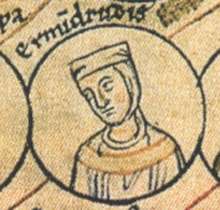Otto-William, Count of Burgundy
| Otto-William, Count of Burgundy | |
|---|---|
| Spouse(s) |
Ermentrude of Roucy Adelaide-Blanche of Anjou |
| Noble family | House of Ivrea |
| Father | Adalbert of Ivrea |
| Mother | Gerberga of Mâcon |
| Born | c. 958 |
| Died | 21 September 1026 |
Otto-William (French: Otte-Guillaume; German: Otto Wilhelm; 955/62 – 21 September 1026 AD), was Count of Mâcon, Count of Nevers, and the Count of Burgundy.
Life
Otto-William of Mâcon was born in 958 during the joint reign of his grandfather, King Berengar II of Italy, and his father, King Adalbert. His mother was Gerberga of Mâcon.[1] His mother gave him what would later be the Free County of Burgundy around Dole in 982. Otto also inherited the duchy of Burgundy on the other side of the Saône in 1002 from his stepfather Eudes Henry the Great.[2] The duchy then corresponded to the diocese of Besançon in the Holy Roman Empire. By 990 Otto-William was the Count of Nevers.[2] He was also Count of Mâcon in France.[1]
While the son of a king, he did not himself seek a royal wife.[3] In c. 975—80 he married Ermentrude of Roucy whose maternal grandmother, Gerberga of Saxony was a sister of Otto I, Holy Roman Emperor and by this marriage alliance it caused a web of consanguinity between later kings of France, Germany, Burgundy and the Carolingians.[3] Even his children's spouses, although from great families, came from widespread and scattered parts of France.[3]
Burgundy was annexed to the crown of France by King Robert II in 1004. Determined to be sovereign ruler of his own lands, Otto revolted against the Emperor Henry II in 1016. This was after Rudolph III of Burgundy, the last king of that realm, had done homage to Henry at Strasbourg making him his guard and heir. On Otto's death, the Free County fell under the suzerainty of the German emperors. Otto-William died 21 September, 1026 at the age of 64.[4]
Marriage and issue

His first wife was Ermentrude, daughter of Renaud of Roucy.[1] They had two sons and three daughters:
- Guy (c. 975—1006) had been associated as count of Mâcon from 995.[1] He married Aelis.
- Matilda, married Landri of Nevers,[1] Count of Nevers[5]
- Gerberga, married Guilhem II of Provence.[1]
- Renaud I, Count of Burgundy (c. 990—1057), he married Adelaide (Judith) of Normandy.[1]
- Agnes, married firstly William V of Aquitaine, secondly Geoffrey II of Anjou.[1]
Otto married the four-times widowed Adelaide-Blanche of Anjou late in life and they had no known children.[6][7]
See also
References
- 1 2 3 4 5 6 7 8 Detlev Schwennicke, Europäische Stammtafeln: Stammtafeln zur Geschichte der Europäischen Staaten, Neue Folge, Band II (Marburg, Germany: Verlag von J. A. Stargardt, 1984), Tafel 59
- 1 2 W. Scott Jessee, Robert the Burgundian and the Counts of Anjou, Ca. 1025-1098 (USA: The Catholic University of America Press. 2000), p. 15
- 1 2 3 Constance Brittain Bouchard, Those of My Blood: Creating Noble Families in Medieval Francia (Philadelphia: The University of Pennsylvania Press, 2001), p. 50
- ↑ David Douglas, 'Some Problems of Early Norman Chronology', The English Historical Review, Vol. 65, No. 256, (Jul., 1950), p. 298
- ↑ Constance Brittain Bourchard, Sword, Miter, and Cloister: Nobility and the Church in Burgundy, 980-1188, (Cornell University Press, 1987), 33.
- ↑ Constance B. Bouchard, 'The Origins of the French Nobility: A Reassessment', The American Historical Review, Vol. 86, No. 3 (Jun., 1981), pp. 515-16.
- ↑ Detlev Schwennicke, Europäische Stammtafeln: Stammtafeln zur Geschichte der Europäischen Staaten, Neue Folge, Band III Teilband 1 (Marburg, Germany: Verlag von J. A. Stargardt, 1984), Tafel 116
External links
- Cawley, Charles, Source on Otto-William, Duke of Burgundy/Count of Mâcon, Medieval Lands database, Foundation for Medieval Genealogy
| Otto-William, Count of Burgundy Died: 21 September 1026 | ||
| Preceded by Odo Henry |
Duke of Burgundy 1002–1004 |
Succeeded by Robert |
| Preceded by none |
Count of Burgundy 982–1026 |
Succeeded by Renaud I |